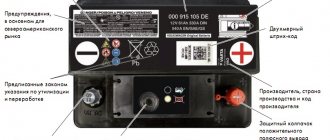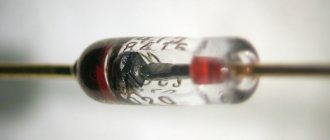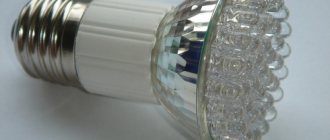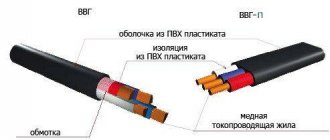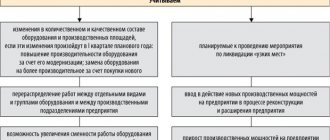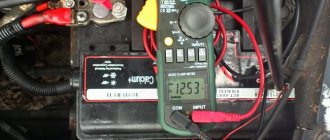How is battery capacity measured?
In the question of what is the energy capacity of a battery, several characteristics are considered - from specific to absolute values. In the technical specifications, the battery capacity is indicated in ampere-hours (Ah) and/or watt-hours (Wh). More accurately, the capabilities of the power source are reflected in watt-hours. This is absolute capacity. Its value shows how much power this battery can produce for 1 hour, regardless of discharge currents and voltage.
For example, a 450 Wh battery can produce 450 watts of power for 1 hour. Specific energy intensity is measured in Wh/kg and shows how much power a given battery weighing 1 kg can provide for 1 hour. The greater the specific energy intensity (in other words, the energy density) of the batteries, the less their mass with an equal amount of accumulated energy.
Capacity in ampere-hours is already a relative value, depending on the rated voltage of the battery. For example, lithium-ion batteries have a nominal voltage of 3.7 V per cell, and lithium iron phosphate (LiFePO4) - 3.2 V. To set the required voltage - 36 V, 48 V, etc. – the batteries are connected to the battery in series. To sum up the capacity of the cells, they are connected in parallel.
Main battery characteristics
Before buying a battery, you need to understand what parameters it must meet. The battery must be compatible with all equipment and the vehicle's electrical system.
Options:
- nominal and reserve electrical capacity;
- starting current;
- power;
- dimensions;
- weight.
To start a car engine you will need not only the necessary reserve of electricity, but also sufficient power.
Electric capacity is the amount of electricity that can be obtained from a battery when it is discharged for a long time.
There are two types of containers:
- Nominal. To determine this, the battery is discharged at 25°C for 20 hours. For this purpose, a current of 5% of the rated capacity declared by the manufacturer is used.
- The reserve capacity is determined by discharging the battery with a current of 25 A at a temperature of 26 °C. This characteristic shows how long in minutes a car can travel with the generator turned off.
We recommend: Ways to test a new car battery when purchasing
In order to figure out how to determine the power of a battery, you will have to remember physics and electrical engineering. Power is the discharge current multiplied by the average voltage in the electrical circuit (P=I*Y).
The formula shows that with an increase in the power required to start the engine, the average voltage in the car network will drop, and the starter will begin to work more slowly. The starting current of a battery is always directly proportional to its power.
It is worth remembering that the starting current and electrical capacity of the new battery should not be less than that of the old one. Otherwise, the battery will be subject to deep discharges and will wear out quickly.
In addition to the starting current, power and battery capacity, it would be useful to pay attention to other necessary parameters:
- polarity of terminals;
- compliance of dimensions;
- fastening.
The condition of the battery and its service life largely depend on the health of the vehicle and operating conditions.
Converting capacity from Ah to Wh
To calculate the absolute constant energy capacity in Wh, knowing the value in Ah, you need to multiply it by the rated voltage of the battery:
Wh (Wh) = V (V) x Ah (Ah).
For example, for a battery with a capacity of 13 Ah and a voltage of 36 V, the absolute energy capacity will be 13 Ah x 36 V = 468 Wh.
Similarly, knowing the absolute constant energy capacity of a battery in Wh, you can calculate its actual capacity at a certain operating voltage of the equipment. To do this, simply divide the absolute capacity in watt-hours by the operating voltage of the load in volts:
Ah (Ah) = Wh (Wh) : V (V).
For example: 468 Wh :36 V =13 Ah, and 468 Wh :24 V =19.5 Ah.
Lead acid battery
Lead-acid batteries are used in vehicles. This storage device is a box filled with electrolyte. Lead plates are immersed in it, separated by porous plastic partitions (separators).
The electrodes are made in the form of a flat lead grid. The cells of the positive (anode) plate are filled with compressed lead dioxide powder. The negative (cathode) is filled with powdered metal lead. The use of powders is necessary to increase the area of contact with the electrolyte, which can significantly increase the capacity.
The operation of an acid battery is based on redox reactions during the interaction of metal lead with its dioxide. They proceed in an electrolyte consisting of distilled water and sulfuric acid.
Features of operation:
- cannot be stored in a discharged state;
- avoid overcharging and boiling;
- monitor the fluid level (add if necessary);
- remove dried electrolyte from the surface of the battery.
Due to the lead content, lead acid batteries are heavy. The weight of the battery, depending on the capacity, can range from 15 to 60 kg.
Conclusions: what affects the energy intensity of an electric bicycle battery?
The travel range on 1 battery charge depends on this characteristic. Approximately, when driving in the most economical mode - on smooth asphalt, without sudden acceleration and braking, headwinds and other obstacles - 8-10 Wh of lithium battery energy is spent for each kilometer of the journey (without pedaling). When pedaling, the cyclist reduces the current consumed by the motor, and therefore the battery energy is used more economically.
Capacity is most accurately and clearly characterized by its absolute constant value, measured in watt-hours. Knowing it, it is easy to determine both the approximate range on 1 charge and the relative capacity in ampere-hours, which depends on the rated voltage of the supplied equipment.
Read in the previous article of our blog about an interesting type of winter electric transport - electric snow scooters.
How to check the capacity of a car battery
There are many ways to determine the battery capacity, because this indicator allows you to find out whether the battery needs to be replaced.
Checking with a tester
One of the fastest and easiest ways to determine the capacity of a car battery. You will need a tester - a device that allows you to simultaneously record several indicators.
Since the testers operate in automatic mode, you do not need any special knowledge - just connect the device to the battery. It takes no more than 15 seconds to get the result you are interested in. A battery is considered unsuitable for use if its current capacity is less than 50% of its original capacity.
Multimeter method
Let's look at how to find out the capacity of a car battery using a multimeter - another multifunctional measuring device that can measure all three main parameters of electric current.
Verification algorithm:
- Let's use the DC measurement mode;
- the required measurement range is set (a little more than the passport data);
- connect the device to the battery;
- We measure the battery capacity by taking readings from the multimeter display.
Load testing
Using a device to measure battery capacity is not necessary, at least at the initial stage - it is enough to let the battery work under load. For example, connect a car light bulb to it. If it dims after a few minutes, it means the battery is either very discharged or simply no longer holds a charge.
The algorithm of actions is as follows:
- disconnect the battery from the generator (remove the terminals);
- connect the load, leave it for a few minutes;
- turn off the load;
- We measure the battery voltage using a voltmeter/multimeter;
- if the device readings are below 12 V, it can be argued that the battery capacity is insufficient to start the engine.
Control discharge technique
The method is characterized by increased accuracy, but it is also the most complex, requiring, in addition to using a multimeter, load calculation.
A multimeter is a universal device. Its presence is very desirable, because with its help you can measure not only the battery capacity.
The load characteristics are determined based on the discharge current - this value may be present on the battery label or in the technical documentation. If you don't have one, the necessary data can be found on the battery manufacturer's website.
The scheme for measuring the capacity of a car is quite simple: the load remains connected until the current strength is approximately halved. After this, the obtained value is compared with the nominal value indicated in the data sheet. If the differences are significant, the battery has degraded to such an extent that its further operation becomes pointless.
Choosing a battery: cold start current - what is this parameter and why is it so important
What is “cold start current”?
Cold start current (or, as it is also called, “cold cranking current”) is the maximum current guaranteed by the battery manufacturer that a new, working battery cooled to -18 degrees can deliver to the consumer, by which we mean, of course, the starter.
This value is always present in the characteristics of any car battery and should be taken into account when purchasing. There are several standards in the world for measuring the cold start value of batteries, which differ from each other. European, Asian, American and several more local ones - Russian, German, etc. And what is good by one standard, is so-so by another. In order for the average car owner not to delve into the specifics of the standards and, even more so, into the methods of converting numbers from one to another, in the vast majority of cases the European standard – EN – is used. It measures the current and writes it on the label, including almost all Russian battery manufacturers. An inscription like “500 A (EN)” is exactly the parameter we need! Sometimes this number is depicted on the battery label in a huge font (which makes you wonder - does it correspond to reality?), sometimes in quite small font:
How much do you have and how much do you need?
500 amps, 550, 600, etc. - this is the current that the battery can deliver. The current is huge. Moreover, we are talking about decent (-18 C) frost - in the warm season, the current value can also be safely increased by one and a half times! Key words - CAN GIVE. But in reality, the battery gives as much as the starter takes. But how much does he charge?
The starters of most gasoline passenger cars consume, even in cold weather, taking into account the oil thickened in the crankcase, much less current - no more than 300 amperes, and most often - up to 200-250. And the batteries of these cars are capable of delivering 500-600 amperes. For diesel and multi-liter gasoline engines, everything is proportional: both the current consumed by the starters is higher and the cold start current of the batteries. The question arises - why do batteries need the ability to deliver starting currents with such a large margin - two to three times?
Everything is explained very simply. When determining the parameters of a standard battery, the car manufacturer takes into account a number of obvious but important points. Firstly, minus 18 degrees, at which the cold start current of the battery is measured - this, as we understand, is far from the cold limit. And cold reduces the battery's current output. If at minus 18 the battery will produce 500 amperes, then at minus 25 it will produce 400 (the numbers are conditional, just for understanding). Something will be taken away from these four hundred amperes by the non-optimal level of charge of the battery (which happens everywhere on cars operated in urban conditions), something else will be lost due to the general level of wear of the battery, if it is not new - slagging, sulfation. And in fact, the battery turns out to be capable of giving the starter only a little more than what it needs... Sometimes almost right back to back. This is what this reserve is designed for, and there are no “extra amps”!
Let's say more - such a battery characteristic as maximum starting current is actually more important than capacity! In cold weather, we value more the battery’s ability to make one (maximum, a couple) attempts to deliver a large current to the starter, rather than the ability to produce one and a half times less current five to ten times.
However, there are also situations in which capacity is of greater importance. For example, a malfunction in the charging system, in which the generator fails and you drive “on battery power”. But in reality, the issue of cold start is much more pressing. A sudden and unpredictable failure of a generator on a regularly serviced machine is still a rare occurrence. And the cold lasts for six months...
We take it with reserve!
We recently talked about why it is very useful and completely safe to install a battery with a capacity larger than the standard one in your car. Cold start current reserve is even more useful. The main limitation on batteries in most modern cars is the fixed dimensions of the battery compartment under the hood, and if, when choosing a new battery for your car, you see several models on the store counter in the required size, but with different cold cranking current, preference (if you have the means) should be given to the one with the highest maximum current.
“For batteries that have the same installation dimensions of length, width and height, the capacity, as a rule, differs slightly, but the starting current can vary significantly,” says Alexander Kazunin, head of the battery laboratory of automotive electronics and electrical equipment of the Federal State Unitary Enterprise NIIAE
:
— For inexpensive models with liquid electrolyte in the range of 55-65 ampere-hours, the cold cranking current is 480-550 Amperes, for expensive ones, in which the “chemistry” of the plate lubrication compositions is much more complex and advanced, it is 620-650 amperes. Let's take a look at any of the popular battery sizes. Well, let's say, 242x175x190 mm. Batteries with such dimensions are found on dozens of car models from different manufacturers. Arriving at the store, the buyer will see among the assortment of batteries in a given size a certain variation in capacity (usually from 55 to 65 ampere-hours) and a much greater variation in cold cranking current. We take the common capacity of 60 ampere-hours - and please, the spread in cold cranking current is from 500 amperes to 600! The difference from minimum to maximum is 100 amperes, which, for a moment, is almost close to the starter consumption on many engines, up to one and a half liters in the summer!
Let's assume that the car's factory-installed battery has a capacity of 60 amp-hours and a cold cranking amps of 550 amps.
If the issue of saving money is not urgent, then for replacement, in addition to the exact same one, we can purchase a battery with higher electrical parameters. Let's say we have two batteries with the same geometric dimensions in length, width and height, but one with an increased capacity of 65 ampere-hours and a starting current like the standard one - 550 amperes, and the second with a capacity like the standard one (60 ampere-hours), but with increased starting current - 600 amperes. In such a situation, it makes sense to prefer the second option. In winter it can help you out a lot!
What is the current maximum?
When choosing a new battery, from two batteries of the same size, it is advisable to choose a model with a higher cold cranking current. What is the limit of this current? Maybe these two are not the best choice and it’s worth looking for more?
If we talk about classic lead-acid batteries with liquid electrolyte for mass-produced passenger cars (without the increasingly expensive AFB and AGM technologies), then the maximum cold start current found among the vast majority of batteries with a capacity of 55 ampere-hours is 560 amperes. The maximum for 60 amp-hour batteries is 640 amps. In the category of 65-amp batteries (this is, as a rule, the limit that fits into the dimensions of the battery compartments of most passenger cars and crossovers), today the technological ceiling for cold cranking current has reached a value of 650-660 amperes. This is an excellent indicator - it is 5-10% higher only for AFB and AGM batteries of the same size and with a similar capacity, which, however, are usually noticeably more expensive. A typical representative of batteries of the highest power category is the South Korean line of CENE batteries from one of the world's battery leaders, JCI Delkor. For example, the CENE 56513 model, with standard dimensions of 242x175x190 mm, has a maximum in-class starting current of 650 amperes and at the same time has a capacity of 65 ampere-hours (that is, it perfectly tolerates the permanent undercharging typical of urban winter). Well, an honest three-year guarantee is like the icing on the cake!
CENE 56513 is available in versions with direct and reverse polarity, and, like all batteries of this brand, is equipped with a comfortable handle and a hydrometer indicator.
The DELKOR company, which produces CENE batteries, was founded in 1985 by General Motors and Daewoo. Today it is part of Clarios, one of the largest battery concerns in the world, and supplies batteries to the assembly lines of Toyota, Honda, Nissan, Hyundai and Kia.
Useful tips
In conclusion, I would like to give literally a few more really important and useful tips. They are no longer aimed at making the right choice, since everything has been said about it, but at extending the service life of the new battery.
- Do not throw your old battery in the trash, even if you have purchased a new battery. Often old batteries can be sold. And directly to the store itself. This will allow you to get an additional discount and save on your purchase.
- Before installing the battery, it is recommended to check the charging relay on your vehicle. Make sure that the relay provides the required voltage. For passenger cars, these parameters range from 13.8 to 14.5 V.
- Even if the new battery is charged, it would not be a bad idea to charge the device at low current. Literally 2-3 hours will be quite enough, which will allow you to bring the device to maximum performance parameters.
- Under no circumstances should the battery be completely discharged. You can charge such batteries, but the service life after each discharge is reduced several times.
- Always keep your charge level under control by simply looking at the corresponding indicator.
- If the vehicle's operating mode involves infrequent and short trips, it is recommended to charge the battery from the network at least once a month.
- Periodically inspect the condition of the terminals, clean them if traces of oxidation processes appear. Otherwise, you may experience undercharging problem.
Nobody says that choosing a battery for a vehicle is easy. But if you rely on some recommendations and follow the advice, every motorist will be able to cope with the task.
You should not skimp on batteries, since only high-quality products can last more than 5 years, cause a minimum of problems and provide your car with the necessary capabilities.
Reasons for replacing the battery
There are several reasons why you may need to replace the old battery with a new one. It is after them that natural questions arise about how to choose the right battery for your car.
- The battery does not hold a charge. This is a cumulative and gradual process. It is important not to wait until the battery fails completely. Often, a battery failure comes as a surprise to a motorist. He comes to the garage, starts the car, and in response there is silence. Only the dashboard indicates that the battery is dead. Although yesterday the charge was full.
- The battery does not want to be charged. Most often, this situation occurs in winter and with fairly worn out batteries. Short trips and low air temperatures simply do not allow the battery to charge. Due to constant discharge, the battery may exhaust its resource, and even the charger will not help.
- Damage appeared. They appear in the form of cracks, leaks, depressurization, etc. Under no circumstances should you use a battery that is damaged.
Sometimes it is possible to restore an old battery. But this does not always result in successful resuscitation. It is possible to restore the device's operation, but it will not last as long as we would like. Plus, a complete failure will occur at any moment.
It is much better to be confident in the battery when going on a long trip or leaving the car in the parking lot for an extended period.
Which battery capacity is best?
If it is necessary to replace the battery, the nominal capacity of the battery is an important parameter that should be paid special attention to. Considering how many batteries are on sale, many car enthusiasts make mistakes.
We also recommend reading the article about the polarity of a car battery. From this article you will learn what polarity is, as well as what needs to be taken into account in terms of polarity when selecting a battery.
Many people believe that the more electrical equipment there is in a car, the more powerful the battery should be. Please note that not every car needs a high capacity battery! Moreover, it is better not to exceed the recommended capacity.
For example, if a passenger car has an engine with a capacity of up to 2.0 liters, a battery with a capacity of 60-72 Ah is sufficient for such an engine. In any case, the battery must be selected taking into account the recommendations of the car manufacturer, and it is better not to exceed the recommended capacity by more than 5 Ah.



